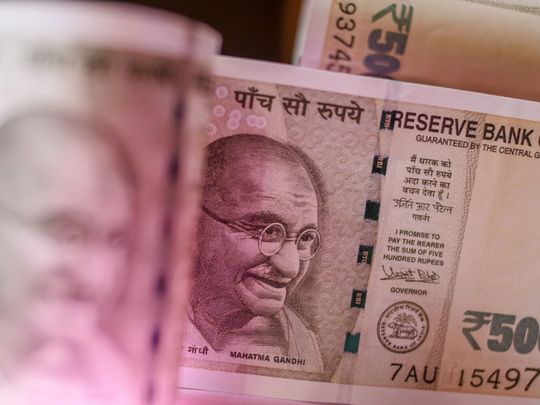
Dubai: The Indian rupee is firming up early Tuesday, at 82.13 to the dollar (22.36 in dirham terms), and slowly moving its way back to October 7 levels, which was when the currency dropped below 82 for the first time.
At one point this morning, the INR was at 82.04, but has since dropped to 82.20 levels.
Today’s relative strength has to do with the dollar run up finally losing some steam. “Whether the rupee continues to regain lost value depends almost entirely on where the dollar is heading next,” said an FX analyst. “We believe, however, the INR rally of today will not sustain, and probably we are looking at 82.04 to 82.52 in the next couple of days.” (The lowest point for the rupee to date is 82.63.)
For the INR-AED currency market and Indian expats, today’s rupee strength wouldn’t matter that much. Most of the remittances at 22 plus to the dirham has already happened this month, with Indian expats cashing in full on the full-blown decline from last week.
Today's currency exchange rate is at 22.23, as against Monday's closing at 22.31 to the dirham.
“Since that sudden drop, the rupee had been moving in a tight range, with opening and closing rates almost unchanged,” said the analyst. “The next remittance pick up will happen only closer to the end of the month, when salaries get credited. Most NRIs in the UAE have by now already taken advantage of the 22 plus rate.”
The other notable currency gainer is the British pound, after the new UK Chancellor Jeremy Hunt did away with just about all the changes his predecessor Kwasi Kwarteng had introduced into his version of a ‘mini-budget’. The pound will start trading at 1.14 to the dollar, moving up from the 1.11 levels. After the Kwasi budget announcement, the British currency had slipped as low as 1.03 and looked at risk of breaking below parity. Hunt’s slew of announcements yesterday will have given some respite.
“Markets appear reassured for now," said Nigel Green of deVere Group. "The pound gained - and gilt yields dropped - as the new chancellor set out his emergency measures aimed at stabilising the extremely choppy waters of the last couple of weeks.
“However, we expect that the new measures to calm financial markets will only work temporarily. The massive loss of credibility cannot be regained all that rapidly. U-turns and abandoning landmark economic policy after economic policy does not inspire investor confidence and trust."
"Reuters reported that the RBI was likely selling dollars and receiving forwards as the central bank tries to keep the currency stable. (At Monday's close) the USD-INR 1-year forward implied yield dropped to 2.45%, its lowest since November 2011, from 2.55% close on Friday.
"Some relief for the local (currency) unit also came via rebounding equities and slightly weaker crude oil prices."











